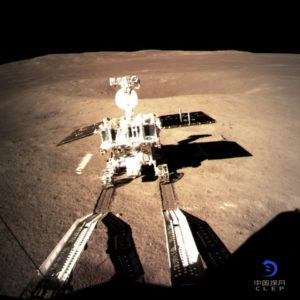Editor’s Note: For another viewpoint of space exploration and public policy, please see Counterpoint: Is Space Still an Awe-Inspiring Frontier?
On January 3, 2019, China became the first nation to make a soft landing of a spacecraft on the far side of the Moon. The subsequent video footage of the Chang’e 4 rover making its way around this unexplored terrain, along with the images of their first-of-its-kind plant experiments, have hearkened us to another era, when NASA’s Apollo astronauts planted the American flag on the Moon and returned home with new science, data and perspective on the world and universe that we all share.
The Apollo missions, however, were set against the backdrop of the Cold War, when space exploration was a proxy for the U.S.-Soviet fight for world leadership. Since the Chang’e 4 landing, part of the ensuing media coverage has spurred new debate about whether a new space race with China is beginning. There are certainly groups in both countries who would like nothing better than to have an old-fashioned geopolitical race between two global powers. But that is a race for a different era and it’s not the one unfolding before us today.
For as strategic as higher ground may be, the forces racing to the Moon are no longer just government assets. Today’s space race is being waged by entrepreneurs and commercial innovators, and this new and inspiring competition is bringing technological revolution faster to space exploration and the commercial marketplace than anything imagined or produced by the Apollo era.
While it’s important to pay attention to what China is doing on the Moon, as well as its other space aspirations, they are not alone in their lunar pursuits. Nations such as India and Israel are planning on sending their own lunar probes in the near future. When you combine those efforts with NASA’s ambitions with its commercial partners for its Gateway program, and any aspirations the Russians may have for visiting and exploring our nearest celestial neighbor, the space race to the Moon is becoming a more crowded enterprise than we could have ever envisioned, even just a few short years ago.
But the challenge to any race is having the resources, training and stamina to finish it. President Kennedy’s challenge to land a man on the Moon before the decade was done was the echoing drumbeat for a generation. While it was not without challenge or debate, as a nation, we made a steadfast commitment to providing those assets to make that lunar race possible. In crossing that finish line 50 years ago, it was vision fulfilled and a national promise kept.
Today, that echoing drumbeat is as different as the racers that are now taking their places on launch pads – government, military and commercial. As much as national pride will drive any country to achieve its goals, today’s space race to the Moon will be won more by the technology-leaping innovations and tactical partnerships than exceed any singular government appropriation by this country or any other.
In the space race of today, no one can afford to go to the Moon, Mars or anywhere else alone. We no longer live or operate in an environment where resources, training and stamina are steadfast, secure or assured. This is why sharing costs and risks with partners and even competitors is a path worthy of consideration as we plot our return to the Moon and endeavor to go beyond it.
That type of environment is what makes the emerging space race even more complex than a clear contest between two different geopolitical forces. The advantage of this new space race environment is that with more participants gaining access to space, global capacity and competence expand and grow beyond where it was originally rooted. The expansion is the rippling wave of opportunity that always comes with exploration.
People go where there is hope, growth and opportunity. Space is that place for many of us in this country, but it is also the same destination for others on this planet too. The costs are very real in terms of lives and national treasure, and any race in this environment is not without risk or challenge. But no market, pursuit or frontier was ever opened without taking those tough considerations in hand.
The tread marks of China’s lunar rover are a sign of the intensifying global competition in space, but it will not be long before there are many more tracks beside them as we, as a world, reach for the Moon and the promise of what lies beyond.

